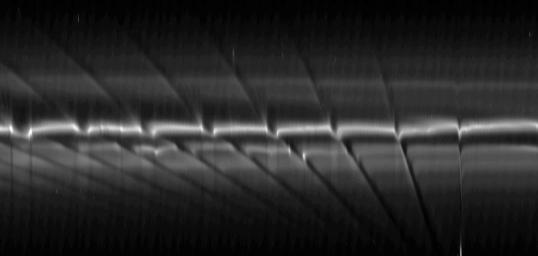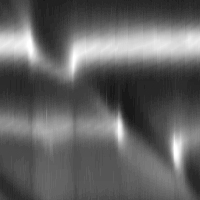
|
“Fan” in the F Ring
- Click the image above for a larger view
- Full-Res JPEG (2100 x 1000) (120.3 kB)
- Full-Res TIFF (2100 x 1000) (2.1 MB)
Caption:
|
|
This mosaic of images from NASA's Cassini spacecraft depicts fan-like structures in Saturn's tenuous F ring. Bright features are also visible near the core of the ring. Such features suggest the existence of additional objects in the F ring.
The bright, discontinuous features seen near the core of the F ring are clumps of ring material that may be created by the passage of the ring's shepherding moon Prometheus. They can be seen casting narrow shadows that extend toward the bottom of the mosaic. The shadows are marked with arrows in the annotated version. From right to left in the mosaic, the blades of the "fan" appear darker than the surrounding material above the bright core of the F ring near the larger, diagonal channels created by the ring's shepherding moon Prometheus. The fans (marked "F" in the annotated version) can be seen as a series of channels within the F ring's particles that appear to have a common origin but that spread outward radially in different directions. Gravitational perturbations on the ring material by a moonlet or clump of material can create these fans. The moonlet or clump orbits more or less elliptically compared to the rest of the F ring. It is probably embedded in the ring and is causing the base of the fan channels to meet. See PIA12785 for similar observations of such fans.
The diagonal streamer-channels are periodically created by the gravity of the potato-shaped moon Prometheus which is 148 kilometers (92 miles) on its longest side but is on average 86 kilometers (53 miles) across. To learn more and to watch a movie of this streamer-channel phenomenon, see PIA08397.
The images have been re-projected in this mosaic so that the F ring appears straightened rather than curved and compressed azimuthally (along the ring). This change represents a scale compression in the horizontal direction of about 33 to one which is why Prometheus looks like a bright line. Prometheus is marked "Pr" in the annotated version.
This sequence of 23 images was taken over about an hour. The earliest image is on the right, and time progresses moving left in the mosaic. Each image was re-projected and placed side by side in this montage. Scale in the original images was about 8 kilometers (5 miles) per pixel. The images were contrast enhanced and re-projected to a scale of 33 kilometers (21 miles) per pixel in the mosaic's horizontal direction and one kilometer (0.6 miles) per pixel in the mosaic's vertical direction. The single, cropped inset of the clumps included here was then magnified by a factor of two.
The view in the original images looked toward the northern, unilluminated side of the rings from about 54 degrees above the ring plane.
The images were taken in visible light with the Cassini spacecraft narrow-angle camera on April 16, 2009. The view was acquired at a distance of approximately 1.3 million kilometers (808,000 miles) from Saturn and at a sun-Saturn-spacecraft, or phase, angle of 98 degrees.
Background Info:
The Cassini-Huygens mission is a cooperative project of NASA, the European Space Agency and the Italian Space Agency. The Jet Propulsion Laboratory, a division of the California Institute of Technology in Pasadena, manages the mission for NASA's Science Mission Directorate, Washington, D.C. The Cassini orbiter and its two onboard cameras were designed, developed and assembled at JPL. The imaging operations center is based at the Space Science Institute in Boulder, Colo.
For more information about the Cassini-Huygens mission visit http://saturn.jpl.nasa.gov/ . The Cassini imaging team homepage is at http://ciclops.org .
Cataloging Keywords:
| Name | Value | Additional Values |
|---|---|---|
| Target | Saturn Rings | F Ring, Prometheus, Saturn |
| System | Saturn | |
| Target Type | Ring | Planet, Satellite |
| Mission | Cassini-Huygens | |
| Instrument Host | Cassini Orbiter | |
| Host Type | Orbiter | |
| Instrument | Imaging Science Subsystem (ISS) | |
| Detector | Narrow Angle Camera | |
| Extra Keywords | Clump, Grayscale, Moonlet, Shadow, Visual | |
| Acquisition Date | ||
| Release Date | 2010-07-20 | |
| Date in Caption | 2009-04-16 | |
| Image Credit | NASA/JPL/Space Science Institute | |
| Source | photojournal.jpl.nasa.gov/catalog/PIA12786 | |
| Identifier | PIA12786 | |


